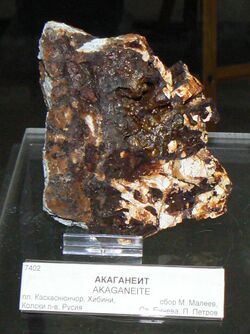Chemistry:Akaganeite
| Akaganeite | |
|---|---|
 A piece of the mineral akaganeite. Exhibit of the "Earth and Man" Museum in Sofia, Bulgaria. Discovered in Kaskasnyunchorr, Khibiny Massif, Kola Peninsula, Russia | |
| General | |
| Category | Oxide mineral |
| Formula (repeating unit) | Fe3+O(OH,Cl) |
| Strunz classification | 4.DK.05 |
| Crystal system | Monoclinic |
| Crystal class | Prismatic (2/m) (same H-M symbol) |
| Space group | I2/m |
| Unit cell | a = 10.561, b = 3.031 c = 10.483 [Å]; β = 90.63°; Z = 1 |
| Identification | |
| Color | Yellowish brown, rusty brown |
| |re|er}} | Earthy |
| Streak | Brownish yellow |
| Diaphaneity | Transparent, translucent |
| Specific gravity | 3.52 |
Akaganeite, also written as the deprecated Akaganéite,[2] is a chloride-containing iron(III) oxide-hydroxide mineral, formed by the weathering of pyrrhotite (Fe1−xS).
Akaganeite is often described as the β phase of anhydrous ferric oxyhydroxide FeOOH, but some chloride (or fluoride) ions are normally included in the structure,[3] so a more accurate formula is FeO0.833(OH)1.167Cl0.167.[4] Nickel may substitute for iron, yielding the more general formula (Fe3+,Ni2+)8(OH,O)16Cl1.25[5]
Akaganeite has a metallic luster and a brownish yellow streak. Its crystal structure is monoclinic and similar to that of hollandite BaMn8O16, characterised by the presence of tunnels parallel to the c-axis of the tetragonal lattice. These tunnels are partially occupied by chloride anions that give to the crystal its structural stability.[4]
Occurrence
The mineral was discovered in the Akagane mine in Iwate, Japan , for which it is named. It was described by the Japanese mineralogist Matsuo Nambu in 1968,[6] but named as early as 1961.[7][8]
Akaganeite has also been found in widely dispersed locations around the world and in rocks from the Moon that were brought back during the Apollo Project. The occurrences in meteorites and the lunar sample are thought to have been produced by interaction with Earth's atmosphere. It has been detected on Mars through orbital imaging spectroscopy.[9]
See also
References
- ↑ Warr, L.N. (2021). "IMA–CNMNC approved mineral symbols". Mineralogical Magazine 85 (3): 291–320. doi:10.1180/mgm.2021.43. Bibcode: 2021MinM...85..291W.
- ↑ Ernst A.J. Burke (2008): "Tidying up Mineral Names: an IMA-CNMNC Scheme for Suffixes, Hyphens and Diacritical marks". Mineralogical Record, volume 39, issue 2.
- ↑ Jongsik Kim and Clare P. Grey (2010), "Li Solid-State MAS NMR Study of Local Environments and Lithium Adsorption on the Iron(III) Oxyhydroxide, Akaganeite (β-FeOOH)". Chemistry of Materials, volume 22, pages 5453–5462. doi:10.1021/cm100816h
- ↑ 4.0 4.1 C. Rémazeilles and Ph. Refait (2007): "On the formation of β-FeOOH (akaganéite) in chloride-containing environments". Corrosion Science, volume 49, issue 2, pages 844-857. doi:10.1016/j.corsci.2006.06.003
- ↑ "Mineral 314-687: Akaganeite". Mindat.org database, accessed on 2019-02-12.
- ↑ Matsuo Nambu (1968): "岩手県赤金鉱山産新鉱物赤金鉱 (β-FeOOH) について (New mineral Akaganeite, β-FeOOH, from Akagane Mine, Iwate Prefecture, Japan)", Journal of the Japanese Association of Mineralogists, Petrologists and Economic Geologists, volume 59, issue 4, pages 143-151,doi:10.2465/ganko1941.59.143
- ↑ Alan Lindsay Mackay (1962): "β-ferric oxyhydroxide - akaganéite", in Mineralogical Magazine and Journal of the Mineralogical Society, volume 33, issue 259, pages 270-280. doi:10.1180/minmag.1962.033.259.02 Cites a private communication by Matsuo Nambu (1961). Note: the diacritic in the title is incorrect, see Burke (2008). Reviewed by Mandarino (1963) in American Minralogist
- ↑ J. A. Mandarino (1963): "New Mineral Names: Akaganéite". American Mineralogist, volume 48, issues 5-6, page 711. Short review of Mackay's communication (1962) in Mineralogical Magazine. Note: the diacritic in the title is incorrect.
- ↑ Carter, John; Viviano-Beck, Christina; Loizeau, Damien; Bishop, Janice; Le Deit, Laetitia (1 June 2015). "Orbital detection and implications of akaganéite on Mars". Icarus 253: 296–310. doi:10.1016/j.icarus.2015.01.020. ISSN 0019-1035. Bibcode: 2015Icar..253..296C.
External links
 |

